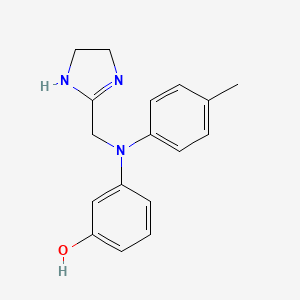Drug Details
| General Information of the Drug (ID: DR3168) | ||||
|---|---|---|---|---|
| Name |
Phentolamine
|
|||
| Synonyms |
phentolamine; Regitine; 50-60-2; Regitin; Fentolamin; Dibasin; Rogitine; Phentolaminum; Fentolamina; C 7337 Ciba; 3-[(4,5-dihydro-1H-imidazol-2-ylmethyl)(4-methylphenyl)amino]phenol; 2-(N-(m-Hydroxyphenyl)-p-toluidinomethyl)imidazoline; 3-(((4,5-Dihydro-1H-imidazol-2-yl)methyl)(p-tolyl)amino)phenol; Phentolamine mesylas; C 7337; UNII-Z468598HBV; 2-(m-Hydroxy-N-p-tolylanilinomethyl)-2-imidazoline; Phenol, 3-(((4,5-dihydro-1H-imidazol-2-yl)methyl)(4-methylphenyl)amino)-; 2-((N-(m-Hydroxyphenyl)-p-toluidino)methyl)-2-imidazoline; 2-(N'-p-Tolyl-N'-m-hydroxyphenylaminomethyl)-2-imidazoline; Phenol, m-(N-(2-imidazolin-2-ylmethyl)-p-toluidino)-; MLS000040874; CHEBI:8081; 2-Imidazoline, 2-((N-(m-hydroxyphenyl)-p-toluidino)methyl)-; Z468598HBV; NCGC00016311-10; Phenotolamine; Phentalamine; Regitipe; SMR000058051; DSSTox_CID_3462; Phenol, 3-[[(4,5-dihydro-1H-imidazol-2-yl)methyl](4-methylphenyl)amino]-; DSSTox_RID_77036; DSSTox_GSID_23462; Phentolamine [INN:BAN]; Fentolamina [INN-Spanish]; Phentolaminum [INN-Latin]; Fentolamine; CAS-50-60-2; Phentolamine (INN); HSDB 3382; EINECS 200-053-1; BRN 0272944; C-7337; Regitina; phentol amine; Rogitine (Salt/Mix); Spectrum_000077; Opera_ID_116; 3-[N-(4,5-dihydro-1H-imidazol-2-ylmethyl)-4-methylanilino]phenol; Prestwick0_000230; Prestwick1_000230; Prestwick2_000230; Prestwick3_000230; Spectrum3_000788; Spectrum4_000899; Spectrum5_001704; CHEMBL597; cid_5775; SCHEMBL5653; Lopac0_000982; BSPBio_000279; BSPBio_001435; BSPBio_002496; GTPL502; KBioGR_001338; KBioSS_000477; 5-25-09-00365 (Beilstein Handbook Reference); cid_91430; MLS001201741; DivK1c_000807; SPBio_002200; BPBio1_000307; PHE035; DTXSID4023462; BCBcMAP01_000014; BDBM31046; KBio1_000807; KBio2_000477; KBio2_003045; KBio2_005613; KBio3_001716; ZINC20251; NINDS_000807; HMS1791H17; HMS1989H17; HMS2089E03; HMS2235D17; HMS3372H21; HMS3402H17; Tox21_110364; BBL010978; STK802099; AKOS004119917; Tox21_110364_1; CCG-205062; DB00692; SDCCGSBI-0050955.P005; CAS-73-05-2; IDI1_000807; SMP1_000236; NCGC00016311-01; NCGC00016311-02; NCGC00016311-03; NCGC00016311-04; NCGC00016311-05; NCGC00016311-06; NCGC00016311-07; NCGC00016311-08; NCGC00016311-09; NCGC00016311-11; NCGC00016311-12; NCGC00016311-13; NCGC00016311-14; NCGC00016311-15; NCGC00016311-16; NCGC00016311-17; NCGC00016311-19; NCGC00016311-33; NCGC00021804-06; NCGC00021804-07; NCGC00021804-08; NCGC00021804-09; NCGC00021804-10; SBI-0050955.P004; DB-050268; FT-0603219; EN300-51916; D08362; AB00053768-28; AB00053768_29; AB00053768_30; 242P985; L001116; Q420360; m-[N-(2-Imidazolin-2-ylmethyl)-p-toluidino]phenol; W-105944; BRD-K90333595-001-02-8; BRD-K90333595-003-04-0; 2-[N-(3-Hydroxyphenyl)-p-toluidinomethyl]-2-imidazolidine; 3-[(4,5-Dihydro-1H-imidazol-2-ylmethyl)-4-methylanilino]phenol #; 3-[4,5-dihydro-1H-imidazol-2-ylmethyl-(4-methylphenyl)amino]phenol; 3-[N-(2-imidazolin-2-ylmethyl)-4-methyl-anilino]phenol;hydrochloride; 3-[N-(2-imidazolin-2-ylmethyl)-4-methyl-anilino]phenol;mesylic acid; 3-[4,5-dihydro-1H-imidazol-2-ylmethyl-(4-methylphenyl)amino]phenol;methanesulfonic acid
Click to Show/Hide
|
|||
| Molecular Type |
Small molecule
|
|||
| Disease | Gangrene [ICD-11: MC85] | Approved | [1] | |
| Structure |

|
Click to Download Mol2D MOL |
||
| Click to Show/Hide the Molecular Information and External Link(s) of This Natural Product | ||||
| Formula |
C17H19N3O
|
|||
| PubChem CID | ||||
| Canonical SMILES |
CC1=CC=C(C=C1)N(CC2=NCCN2)C3=CC(=CC=C3)O
|
|||
| InChI |
1S/C17H19N3O/c1-13-5-7-14(8-6-13)20(12-17-18-9-10-19-17)15-3-2-4-16(21)11-15/h2-8,11,21H,9-10,12H2,1H3,(H,18,19)
|
|||
| InChIKey |
MRBDMNSDAVCSSF-UHFFFAOYSA-N
|
|||
| CAS Number |
CAS 50-60-2
|
|||
| ChEBI ID | ||||
| TTD Drug ID | ||||
| DrugBank ID | ||||
| Combinatorial Therapeutic Effect(s) Validated Clinically or Experimentally | ||||||
|---|---|---|---|---|---|---|
| α. A List of Natural Product(s) Able to Enhance the Efficacy of This Drug | ||||||
| L-arginine | Escherichia coli | Click to Show/Hide the Molecular Data of This NP | ||||
| Achieving Therapeutic Synergy | Click to Show/Hide | |||||
| Representative Experiment Reporting the Effect of This Combination | [2] | |||||
| Detail(s) |
Combination Info
 click to show the detail info of this combination
click to show the detail info of this combination
|
|||||
| Biological
Regulation |
Increase | Maximum relaxation | ||||
| In-vivo Model | Male New Zealand white rabbits (3 to 3.5kg) were used in this study. | |||||
| Experimental
Result(s) |
The study demonstrated a synergistic interaction between the alpha-adrenergic blockade and the potentiation of the nitric oxide/cyclic guanosine monophosphate pathway to increase neurogenic relaxation of trabecular smooth muscle relaxation. | |||||
| Target and Pathway | ||||
|---|---|---|---|---|
| Target(s) | Dopamine D2 receptor (D2R) | Molecule Info | [3] | |
| KEGG Pathway | Rap1 signaling pathway | Click to Show/Hide | ||
| 2 | cAMP signaling pathway | |||
| 3 | Neuroactive ligand-receptor interaction | |||
| 4 | Gap junction | |||
| 5 | Dopaminergic synapse | |||
| 6 | Parkinson's disease | |||
| 7 | Cocaine addiction | |||
| 8 | Alcoholism | |||
| Panther Pathway | Heterotrimeric G-protein signaling pathway-Gi alpha and Gs alpha mediated pathway | Click to Show/Hide | ||
| 2 | Heterotrimeric G-protein signaling pathway-Gq alpha and Go alpha mediated pathway | |||
| 3 | Dopamine receptor mediated signaling pathway | |||
| 4 | Nicotine pharmacodynamics pathway | |||
| Reactome | Dopamine receptors | Click to Show/Hide | ||
| 2 | G alpha (i) signalling events | |||
| WikiPathways | Hypothetical Network for Drug Addiction | Click to Show/Hide | ||
| 2 | Monoamine GPCRs | |||
| 3 | GPCRs, Class A Rhodopsin-like | |||
| 4 | Genes and (Common) Pathways Underlying Drug Addiction | |||
| 5 | GPCR ligand binding | |||
| 6 | GPCR downstream signaling | |||
| 7 | Nicotine Activity on Dopaminergic Neurons | |||

